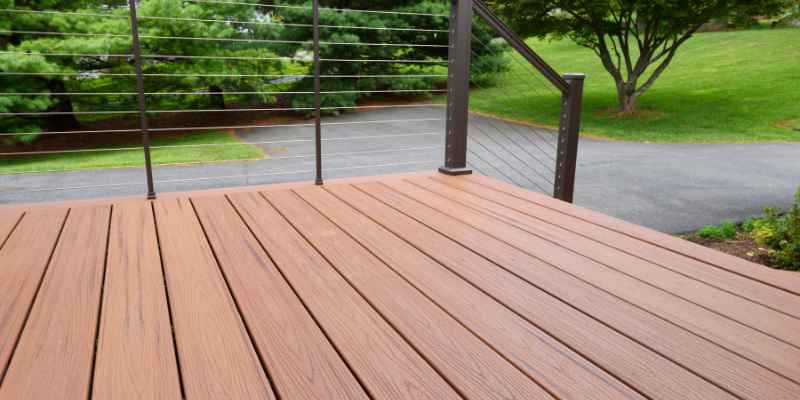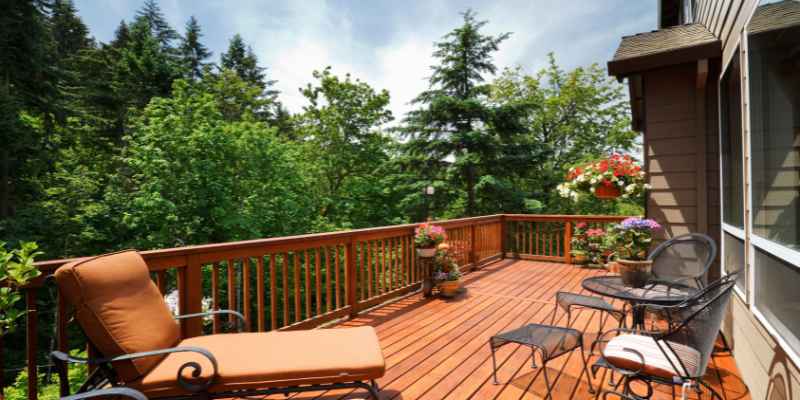Modified wood decking refers to wood that has been treated thermally or chemically to enhance its properties. This process changes the characteristics of the wood, making it more durable and resistant to decay, insects, and weathering.
It is a popular choice for decking because of its improved performance and sustainability compared to standard timber. Modified wood decking offers the benefits of natural wood aesthetics while being environmentally friendly and long-lasting. With its enhanced durability and resistance, it provides a low-maintenance and visually appealing option for outdoor decking projects.
Thermally Modified Wood
Thermally Modified Wood Decking offers enhanced durability and longevity through a specialized heating process that alters its properties. This innovative technique provides a natural alternative to chemical treatments for decks, ensuring a sustainable and eco-friendly choice for outdoor spaces.
Durability
Thermally modified wood offers exceptional durability due to the thermal treatment process altering its cellular structure.
Thermal Modification Process
The thermal modification process involves heating the wood in a controlled environment to enhance its properties.
Profile
The profile of thermally modified wood decking showcases a unique blend of natural aesthetics and enhanced strength.
Maintaining Tone
Maintaining the tone of thermally modified wood decking is relatively easy with proper care and periodic treatments.
Seasonal Maintenance
Seasonal maintenance for thermally modified wood decking involves regular cleaning and protective coatings to prolong its lifespan.
Advantages And Disadvantages
Thermally modified wood is gaining popularity as a sustainable option for decking. It goes through a thermal modification process that enhances its durability and stability. However, like any other material, it also comes with its advantages and disadvantages.
Advantages Of Thermally Modified Wood
- Enhanced durability: Thermally modified wood is highly resistant to rot, decay, and insect damage, making it a long-lasting option for decking.
- Increased stability: The thermal modification process reduces moisture content in the wood, minimizing swelling and shrinking, which can lead to warping and cracking.
- Natural beauty: Thermally modified wood retains its natural colors and patterns, offering an aesthetically pleasing option for decking.
- Chemical-free: Unlike pressure-treated wood, thermally modified wood does not require chemical additives to enhance its durability, making it an eco-friendly choice.
Disadvantages Of Thermally Modified Wood
- Decreased flexibility: The thermal modification process can make the wood more brittle, limiting its flexibility for certain applications.
- Challenging saw cuts: Due to the dryness of thermally modified wood, achieving clean and precise cuts can be more difficult. It requires a sharp blade and careful handling.
- Higher cost: Thermally modified wood decking can be more expensive compared to traditional wood options.
- Limited availability: Although the demand is increasing, thermally modified wood may not be as readily available as other decking materials.
Comparison With Pressure-treated Wood
When comparing thermally modified wood with pressure-treated wood, there are some noticeable differences. While pressure-treated wood is chemically treated to enhance its durability, thermally modified wood achieves its durability through a natural thermal modification process.
One key difference is the appearance. Pressure-treated wood may have a slight green tint due to the preservatives used, whereas thermally modified wood retains its natural caramel color. With time, pressure-treated wood may fade to a natural tan color.
Additionally, thermally modified wood offers the advantage of being chemical-free, making it a more sustainable and environmentally friendly option compared to pressure-treated wood.
Although thermally modified wood has its advantages and disadvantages, it is ultimately a versatile and durable option for decking, especially for those looking for a natural and eco-friendly material.
Environmental Benefits
Modified wood decking offers numerous environmental benefits compared to traditional wood options. By undergoing thermal or chemical modifications, the characteristics of the wood are enhanced, resulting in enhanced durability and improved resistance to decay and insect damage. This eliminates the need for chemical treatments and preserves the natural beauty of the wood, making it a sustainable and eco-friendly choice for decking.
Natural Bio-based Liquid Vs. Chemical-based Products
When it comes to the environmental benefits of modified wood decking, one key factor to consider is the choice between natural bio-based liquid and chemical-based products. Unlike traditional decking materials that are loaded with chemical-based products, modified wood, such as Kebony, uses a natural, bio-based liquid to achieve its superior performance characteristics. This makes it a much more environmentally friendly option.
Chemical-based products used in traditional decking materials can have negative impacts on the environment. These chemicals may leach into the soil and waterways, causing harm to plants, animals, and even humans. In contrast, the natural bio-based liquid used in modified wood is derived from sustainable sources and does not pose the same environmental risks.
The benefits of using a natural bio-based liquid in modified wood decking include:
- Reduced carbon footprint: The production of natural bio-based liquids has a lower carbon footprint compared to the manufacturing of chemical-based products. This contributes to a more sustainable and eco-friendly decking option.
- Renewable materials: Natural bio-based liquids are derived from renewable sources, such as plant-based oils. These materials can be easily replenished, ensuring a more sustainable decking choice.
- Less toxicity: Chemical-based products often contain harmful toxins, such as volatile organic compounds (VOCs). Natural bio-based liquids, on the other hand, have lower toxicity levels, reducing the negative impact on indoor air quality and overall environmental health.
- Better long-term performance: Modified wood decking with natural bio-based liquids has been proven to have superior performance and durability compared to chemical-based alternatives. It can withstand harsh weather conditions, resist rotting and decay, and maintain its beauty for longer periods of time.
Conclusion
Choosing modified wood decking with a natural bio-based liquid offers numerous environmental benefits. It reduces the carbon footprint, utilizes renewable materials, minimizes toxicity, and provides long-term performance. By opting for this sustainable decking option, you can enjoy a beautiful outdoor space while also making a positive impact on the environment.
Longevity And Maintenance
When it comes to selecting decking material, longevity and maintenance are crucial factors to consider. Modified wood decking, particularly thermally modified wood, offers unique benefits in terms of durability and upkeep. Let’s delve into the lifespan and maintenance aspects of thermally modified wood decking.
Lifespan Of Thermally Modified Wood
Thermally modified wood boasts an impressive lifespan of up to 25 years, making it a durable choice for decking projects. The thermal modification process enhances the wood’s stability and resistance to decay, prolonging its lifespan compared to traditional wood options.
Comparison Of Maintenance With Other Wood Options
When it comes to maintenance, thermally modified wood requires minimal upkeep compared to other wood options. Here’s a breakdown of the maintenance comparison:
| Aspect | Thermally Modified Wood | Other Wood Options |
|---|---|---|
| Regular Sealing | Not required | Often needed |
| Resistance to Decay | Highly resistant | May need frequent treatments |
| Color Retention | Maintains tone well | May require staining or painting |
- Modified wood decking eliminates the need for regular sealing, reducing maintenance tasks.
- Thermally modified wood exhibits high resistance to decay, minimizing the need for frequent treatments.
- The wood maintains its tone well over time, reducing the necessity for staining or painting.
Overall, thermally modified wood decking offers a longer lifespan and lower maintenance requirements compared to traditional wood options, making it a sustainable and cost-effective choice for outdoor projects.
Popularity And Availability

Modified wood decking has recently gained significant popularity due to its enhanced durability, sustainability, and unique aesthetic appeal. This eco-friendly alternative to traditional decking materials has become increasingly sought after by homeowners and builders alike. Additionally, the availability of various brands and suppliers offering modified wood decking has contributed to its growing demand in the market.
Rising Popularity Of Modified Wood Decking
The rising popularity of modified wood decking can be attributed to its eco-friendly nature and exceptional durability. With a growing emphasis on sustainability and environmental consciousness, consumers are increasingly seeking decking materials that offer long-term benefits without compromising the environment. Modified wood, which undergoes thermal or chemical treatments to enhance its properties, has emerged as a favored choice for eco-conscious individuals seeking durable and aesthetically appealing decking solutions.
Available Brands And Suppliers
Several reputable brands and suppliers offer a wide range of modified wood decking products, providing customers with diverse options to suit their specific preferences and project requirements. These include renowned manufacturers such as Arbor Wood Co., Kebony, and others, which specialize in producing high-quality modified wood decking materials. Furthermore, numerous suppliers distribute these products, ensuring accessibility and availability in the market.
Sustainable Decking
When it comes to decking, sustainability is a key factor to consider. Modified wood decking offers a sustainable alternative that not only enhances the visual appeal of the outdoor space but also minimizes the environmental impact. In this section, we will delve into the sustainability of modified wood decking and explore its chemical-free attributes.
Sustainability Of Modified Wood Decking
Modified wood decking is renowned for its sustainable properties. The thermal or chemical modification process enhances the wood’s natural characteristics, resulting in a product that is resistant to decay, insect damage, and moisture. This increased durability prolongs the lifespan of the decking, reducing the need for frequent replacement and minimizing overall environmental impact.
Furthermore, many manufacturers source responsibly managed forests for their raw materials, ensuring that the production of modified wood decking contributes to forest conservation and supports sustainable forestry practices.
Chemical-free Alternative
Unlike traditional pressure-treated wood, modified wood decking offers a chemical-free alternative. The modification process relies on heat or natural compounds, eliminating the need for harmful chemical preservatives. This not only makes the decking more environmentally friendly but also creates a safer outdoor environment for families and pets.
Moreover, the absence of toxic chemicals in modified wood decking makes it a health-conscious choice for eco-minded homeowners who prioritize the well-being of their families and the environment.

Frequently Asked Questions On What Is Modified Wood Decking
What Is The Difference Between Wood And Modified Wood?
Modified wood differs from standard wood by being thermally or chemically altered to enhance its properties.
What Are The Disadvantages Of Thermally Modified Wood?
The disadvantages of thermally modified wood include reduced flexibility and difficulty in achieving a beautiful saw cut due to dryness. It requires a sharp blade, and some find its caramel color to be a downside.
How Long Does Thermally Modified Wood Last?
Thermally modified wood can last up to 25 years due to the enhancement of its properties through a thermal or chemical process. It is a durable and long-lasting option for decking or any other outdoor applications.
What Is The Difference Between Pressure-treated Wood And Thermally Modified Wood?
Pressure-treated wood has a green tint, while thermally modified wood retains a natural caramel color. The difference lies in the treatment process – chemicals for pressure-treated, thermal or chemical changes for modified wood.
Conclusion
Modified wood decking offers a range of advantages over traditional wood decking options. With its enhanced durability, resistance to rot and decay, and improved dimensional stability, modified wood is a smart choice for decking projects. The thermally or chemically modified characteristics of this type of wood enhance its performance and longevity, making it a reliable and long-lasting option.
In addition, modified wood decking is environmentally friendly, as it often uses natural, bio-based liquids instead of harsh chemicals. Consider opting for modified wood decking to create a beautiful and sustainable outdoor space.


